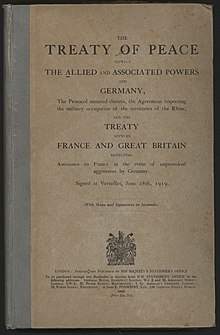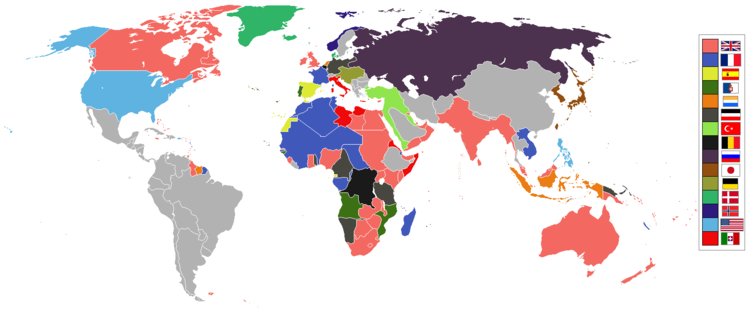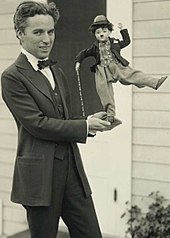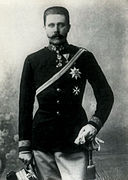1910s

| Millennium |
|---|
| 2nd millennium |
| Centuries |
| Decades |
| Years |
| Categories |
The1910s(pronounced "nineteen-tens" often shortened to the "'10s"or the"Tens") was thedecadethat began on January 1, 1910, and ended on December 31, 1919.
The 1910s represented the culmination of Europeanmilitarismwhich had its beginnings during the second half of the 19th century. The conservative lifestyles during the first half of the decade, as well as the legacy ofmilitary alliances,were forever changed by the June 28, 1914assassination of Archduke Franz Ferdinand,theheir presumptiveto theAustro-Hungarianthrone. The archduke's murder triggered a chain of events in which, within 33 days,World War Ibroke out in Europe on August 1, 1914. The conflict dragged on until atrucewas declared on November 11, 1918, leading to the controversial and one-sidedTreaty of Versailles,signed on June 28, 1919.
The war's end triggered theabdicationof variousmonarchiesand the collapse of four of the last modern empires ofRussia,Germany,Ottoman Turkey,andAustria-Hungary,with the latter splintered into Austria, Hungary, southern Poland (who acquired most of their land in a war with Soviet Russia), Czechoslovakia and Yugoslavia, as well as the unification of Romania with Transylvania and Bessarabia.[a]However, each of these states (with the possible exception of Yugoslavia) had large German and Hungarian minorities, creating some unexpected problems that would be brought to light in the next two decades.
The decade was also a period of revolution in many countries. The Portuguese5 October 1910 revolution,which ended the eight-century-long monarchy, spearheaded the trend, followed by theMexican Revolutionin November 1910, which led to the ousting ofdictatorPorfirio Díaz,developing into a violentcivil warthat dragged on until mid-1920, not long after a newMexican Constitutionwas signed and ratified. TheRussian Empirehad a similar fate, since its participation inWorld War Iled it to a social, political, and economical collapse which made thetsarist autocracyunsustainable and, succeeding theevents of 1905,culminated in theRussian Revolutionand the establishment of theRussian Soviet Federative Socialist Republic,under the direction of the Bolshevik Party, later renamed as theCommunist Party of the Soviet Union.The Russian Revolution of 1918, known as theOctober Revolution,was followed by theRussian Civil War,which dragged on until approximately late 1922. China saw 2,000 years of imperial rule ended with theXinhai Revolution,becoming a nominalrepublicuntilYuan Shikai's failed attempt torestorethe monarchy and his death started theWarlord Erain 1916.

Much of the music in these years wasballroom-themed. Many of the fashionable restaurants were equipped with dance floors.Prohibition in the United Statesbegan January 16, 1919, with theratificationof theEighteenth Amendmentto theU.S. Constitution.Best-selling books of this decadeincludeThe Inside of the Cup,Seventeen,Mr. Britling Sees It Through,andThe Four Horsemen of the Apocalypse.
During the 1910s, the world population increased from 1.75 to 1.87 billion, with approximately 640 million births and 500 million deaths in total.
Politics and wars[edit]

Wars[edit]
- World War I(1914–1918)
- Theassassination of Archduke Franz FerdinandofAustria-HungaryinSarajevoleads to the outbreak of the First World War.
- TheArmenian genocideduring and just after World War I. It was characterized by the use ofmassacresanddeportationsinvolvingforced marchesunder conditions designed to lead to the death of the deportees, with the total number of Armenian deaths generally held to have been between one and one-and-a-half million.[1][2][3]
- TheArab Revoltwas an armed uprising ofArabsagainst theOttoman Empire.
- Germanysigns theTreaty of Versaillesafter losing the First World War.
- Wadai War(1909–1911)
- Italo-Turkish War(1911–1912)
- First Balkan Wars(1912–1913) – two wars that took place in South-eastern Europe in 1912 and 1913.
- Saudi-Ottoman War(1913)
- Latvian War of Independence(1918–1920) – a military conflict in Latvia between the Republic of Latvia and the Russian SFSR.
Internal conflicts[edit]
- TheOctober RevolutioninRussiaresults in the overthrow ofcapitalismand the establishment of the world's first self-proclaimedsocialist state;political upheaval in Russia culminating in the establishment of theRussian SFSRand the assassination of EmperorNicholas IIand the royal family.
- TheRussian Revolutionis the collective term for the series of revolutions inRussiain 1917, which destroyed theTsarist autocracyand led to the creation of theSoviet Union.It led to theRussian Civil Warand other conflicts such as theFinnish Civil War,theUkrainian War of Independenceand thePolish–Soviet War.
- TheJallianwala Bagh massacre(1919), atAmritsarin thePunjab ProvinceofBritish India,sows the seeds of discontent and leads to the birth of theIndian independence movement.
- TheXinhai Revolutioncauses the overthrow of China's rulingQing dynasty,and the establishment of theRepublic of China.TheWarlord Era(1916–1928) began.
- TheMexican Revolution(1910–1920)Francsico Maderoproclaims the elections of 1910 null and void and calls for an armed revolution at 6 p.m. against the illegitimate presidency/dictatorship ofPorfirio Díaz.The revolution led to the ousting of Díaz (who ruled from 1876 to 1880 and since 1884) six months later. The revolution progressively became a civil war with multiple factions and phases, culminating with theMexican Constitution of 1917,but combat would persist for three more years.
Major political change[edit]

- Portugal became the first republican country in the century after the5 October 1910 revolution,ending its long-standing monarchy and creating theFirst Portuguese Republicin 1911.
- Germany abolished its monarchy and became under the rule of a new elected government called theWeimar Republic.
- Seventeenth Amendment to the United States Constitutionis passed, requiring US senators to be directly elected rather than appointed by thestate legislatures.
- Federal Reserve Actis passed in 1913 by theUnited States Congress,establishing aCentral Bankin the US.
- On the death ofEdward VII,his sonGeorge Vbecomes King of theUnited Kingdomand the British Dominions, andEmperor of India.TheCoronation of George V and Marytakes place on 22 June 1911.
- Dissolution of theGerman colonial empire,Ottoman Empire,Austria-Hungaryand theRussian Empire,reorganization of European states, territorial boundaries, and the creation of several new European states and territorial entities:Austria,Czechoslovakia,Estonia,Finland,Free City of Danzig,Hungary,Latvia,Lithuania,Poland,Saar,Ukraine,andYugoslavia.
- Fourteen Pointsas designed byUnited States PresidentWoodrow Wilsonadvocates the right of all nations toself-determination.
- Rise to power of theBolsheviksin Russia underVladimir Lenin,creating theRussian Soviet Federated Socialist Republic,the first state committed to the establishment ofcommunism.
- TheBalfour Declarationwas a declaration by the British Government that announced the British desire to establish a Jewish homeland in Palestine. This declaration has often been characterized as a betrayal of the Arabs and the agreement between the British andSharif Hussein of Meccain theMcMahon-Hussein Correspondencewhich promised freedom to all Arab lands from theOttoman Empire.[4][5][6]
- Zionismbecomes more popular after theBalfour Declaration.[where?]
Decolonization and independence[edit]
- TheEaster Risingagainst theBritishinIrelandeventually leads toIrish independence.
- Several nations inEastern Europeget their nation-state, thereby replacing major multiethnic empires.
- TheRepublic of Chinawas established on January 1, 1912.
Assassinations[edit]
Prominent assassinations include:
- March 18, 1913:George I of Greece
- June 11, 1913:Mahmud Şevket Pasha,Grand Vizierof theOttoman Empire
- June 28, 1914: ArchdukeFranz FerdinandofAustria-HungaryisassassinatedinSarajevo,Bosnia and Herzegovina; prompting the events that led up to the start ofWorld War I.
- July 17, 1918:Murder of the Romanov family,including former Russian EmperorNicholas II,his consortAlix of Hesse,their five children, and four retainers at theIpatiev HouseinYekaterinburgfollowing theOctober Revolutionof 1917, and the usurpation of power by theBolsheviks.
- April 10, 1919:Emiliano Zapatain Mexico.
Disasters[edit]
This sectionneeds expansion.You can help byadding to it.(January 2010) |


- TheRMSTitanic,a Britishocean linerwhich was the largest and most luxurious ship at that time, struck an iceberg and sank two hours and 40 minutes later in theNorth Atlanticduring its maiden voyage on April 15, 1912. 1,517 people perished in the disaster.
- On May 29, 1914, the British ocean linerRMSEmpress of Irelandcollided in thick fog with theSSStorstad,a Norwegiancollier,near the mouth ofSaint Lawrence RiverinCanada,sinking in 14 minutes. 1,012 people died.
- On May 7, 1915, the British ocean linerRMSLusitaniawas torpedoed byU-20,a GermanU-boat,off theOld Head of Kinsalein Ireland, sinking in 18 minutes. 1,199 people died.
- On November 21, 1916, theHMHSBritannicwas holed in an explosion while passing through a channel that had been seeded with enemy mines and sank in 55 minutes.
- From 1918 through 1920, theSpanish flukilled from 17.4 to 100 million people worldwide.
- In 1916, theNetherlandswas hit by aNorth Seastorm that flooded the lowlands and killed 19 people.
- From July 1 to July 12, 1916, a series of shark attacks, known as theJersey Shore shark attacks of 1916,occurred along the Jersey Shore, killing four and injuring one.
- On January 11, 1914,Sakurajimaerupted which resulted in the death of 35 people. In addition, the surrounding islands were consumed, and anisthmuswas created between Sakurajima and the mainland.
- In 1917, theHalifax Explosionkilled 2,000 people.
- In 1919, theGreat Molasses Floodin Boston, Massachusetts killed 21 people and injured 150.
Other significant international events[edit]
- ThePanama Canalis completed in 1914.
- World War Ifrom 1914 until 1918 dominates the Western world.
- Hiram BinghamrediscoversMachu Picchuon July 24, 1911.
- Islamicmovements, such asLiberal IslamandIslamic modernism,that reject orthodox beliefs to varying degrees are at their most prominent position yet.[7]
Science and technology[edit]
Technology[edit]

- Gideon Sundbackpatented the first modernzipper.[8]
- Harry Brearleyinventedstainless steel.[9]
- Charles Striteinvented the first pop-up breadtoaster.[10]
- TheModel T Forddominated theautomobilemarket, selling more than all other makers combined in 1914.[11]
- Thearmy tankwas invented.Tanks in World War Iwere used by theBritish Army,theFrench Armyand theGerman Army.[12]
- In 1912articulatedtrams, were invented and first used by theBoston Elevated Railway.[13]
Science[edit]
- In 1916,Albert Einstein's theory ofgeneral relativity.[14]
- Max von Lauediscovers thediffractionofx-raysbycrystals.[15]
- In 1912,Alfred Wegenerputs forward his theory ofcontinental drift.[16]
Economics[edit]
- In the years 1910 and 1911, there was a minor economic depression known as thePanic of 1910–1911,which was followed by the enforcement of theSherman Anti-Trust Act.
Popular culture[edit]
- Flying Squadron of Americapromotestemperance movement in the United States.
- Edith Smith Davisedits the Temperance Educational Quarterly.
- The first U.S.feature film,Oliver Twist,was released in 1912.
- The firstmob film,D. W. Griffith'sThe Musketeers of Pig Alley,was released in 1912.
- Hollywood, California,replaces theEast Coastas the center of the movie industry.
- The firstcrossword puzzlewas published 21 December 1913 appearing inThe New York Worldnewspaper.
- The comic stripKrazy Katbegins.
- Charlie Chaplindébuts his trademark mustached, baggy-pants "Little Tramp"character inKid Auto Races at Venicein 1914.
- The firstAfrican Americanowned studio, theLincoln Motion Picture Company,was founded in 1917.
- The fourWarner brothers,(from older to younger)Harry,Albert,Samuel,andJackopened their first major film studio inBurbankin 1918.
- Tarzan of the ApesstarringElmo Lincolnis released in 1918, the firstTarzanfilm.
- The firstjazzmusic is recorded by the Original Dixieland Jass Band for Victor (#18255) in late February 1917.
- TheSalvation Armyhas a new international leader, GeneralBramwell Boothwho served from 1912 to 1929. He replaces his father and co-founder of the Christian Mission (the forerunner of the Salvation Army),William Booth.
Sports[edit]
- 1912 Summer Olympicswere held inStockholm,Sweden.
- 1916 Summer Olympicswere cancelled because ofWorld War I.
Literature and arts[edit]
Below are the best-selling books in the United States of each year, as determined byThe Bookman,a New York-based literary journal (1910–1912) andPublishers Weekly(1913 and beyond).[17]
- 1910:The RosarybyFlorence L. Barclay
- 1911:The Broad HighwaybyJeffery Farnol
- 1912:The HarvesterbyGene Stratton Porter
- 1913:The Inside of the CupbyWinston Churchill
- 1914:The Eyes of the WorldbyHarold Bell Wright
- 1915:The TurmoilbyBooth Tarkington
- 1916:SeventeenbyBooth Tarkington
- 1917:Mr. Britling Sees It ThroughbyH. G. Wells
- 1918:The U.P. TrailbyZane Grey
- 1919:The Four Horseman of the ApocalypsebyVicente Blasco Ibáñez
Visual Arts[edit]
-
Pablo Picasso,Portrait of Daniel-Henry Kahnweiler,1910,The Art Institute of Chicago.Pablo PicassoandGeorges Braqueco-inventCubism,revolutionizing the art of painting and advancing the concepts ofModern artandModernism.
-
Henri Matisse,L'Atelier Rouge,1911, oil on canvas, 162 × 130 cm.,The Museum of Modern Art,New York City
-
Marcel Duchamp,Fountain,1917, Duchamp introduces hisReadymades,as an example ofDadaandAnti-art.Photograph byAlfred Stieglitz
-
Armory Showposter, 1913, Internationally groundbreaking exhibition ofModern art
The 1913Armory ShowinNew York Citywas a seminal event in the history ofModern Art.Innovative contemporaneous artists from Europe and the United States exhibited together in a massive group exhibition in New York City, andChicago.
Art movements[edit]
[edit]
[edit]
[edit]
Other movements and techniques[edit]
Influential artists[edit]
- Pablo Picasso
- Georges Braque
- Henri Matisse
- Jean Metzinger
- Marcel Duchamp
- Wassily Kandinsky
- Albert Gleizes
- Kasimir Malevich
- Giorgio de Chirico
- Robert Frost
People[edit]
Business[edit]

- Arnold Rothstein,gangster, gambler, fixed the1919 World Series
- Henry Ford,founder of theFord Motor Company
Inventors[edit]
Politics[edit]
- John Barrett,Director-generalOrganization of American States
- George Louis Beer,ChairmanPermanent Mandates Commission
- Henry P. Davison,ChairmanInternational Federation of Red Cross and Red Crescent Societies
- SirJames Eric Drummond,Secretary-generalLeague of Nations
- Emil Frey,DirectorInternational Telecommunication Union
- Christian Louis Lange,Secretary-generalInter-Parliamentary Union
- Baron Louis Paul Marie Hubert Michiels van Verduynen, Secretary-generalPermanent Court of Arbitration
- William E. Rappard, Secretary-general International Federation of Red Cross and Red Crescent Societies
- Manfred von Richthofen,alias the "Red Baron", fighter pilot
- Eugène Ruffy,DirectorUniversal Postal Union
- William Napier Shaw,PresidentWorld Meteorological Organization
- Albert Thomas,DirectorInternational Labour Organization
- Grigory Yevseyevich Zinoviev,Chairman of theExecutive Committee of the Communist International
Authors[edit]
Entertainers[edit]



- Fatty Arbuckle
- Theda Bara
- Richard Barthelmess
- Béla Bartók
- Irving Berlin
- Eubie Blake
- Shelton Brooks
- Lew Brown
- Tom Brown
- Anne Caldwell
- Eddie Cantor
- Enrico Caruso
- Charlie Chaplin
- Lon Chaney
- George M. Cohan
- Henry Creamer
- Bebe Daniels
- Cecil B. DeMille
- Buddy De Sylva
- Walter Donaldson
- Marie Dressler
- Eddie Edwards
- Gus Edwards
- Douglas Fairbanks
- Fred Fisher
- John Ford
- Eddie Foy
- George Gershwin
- Beniamino Gigli
- Dorothy Gish
- Lillian Gish
- Samuel Goldwyn
- D. W. Griffith
- W. C. Handy
- Otto Harbach
- Lorenz Hart
- Victor Herbert
- Harry Houdini
- Charles Ives
- Tony Jackson
- Emil Jannings
- William Jerome
- Al Jolson
- Gus Kahn
- Gustave Kahn
- Buster Keaton
- Jerome David Kern
- Ring Lardner
- Nick LaRocca
- Harry Lauder
- Florence Lawrence
- Ted Lewis
- Harold Lloyd
- Charles McCarron
- Joseph McCarthy
- Winsor McCay
- Oscar Micheaux
- Mae Murray
- Alla Nazimova
- Pola Negri
- Anna Q. Nilsson
- Ivor Novello
- Alcide Nunez
- Geoffrey O'Hara
- Sidney Olcott
- Jack Pickford
- Mary Pickford
- Armand J. Piron
- Cole Porter
- American Quartet
- Richard Rodgers
- Sigmund Romberg
- Jean Schwartz
- Mack Sennett
- Larry Shields
- Chris Smith
- Erich von Stroheim
- Arthur Sullivan
- Gloria Swanson
- Wilber Sweatman
- Blanche Sweet
- Albert Von Tilzer
- Harry Von Tilzer
- Musicians of the Titanic
- Sophie Tucker
- Pete Wendling
- Pearl White
- Bert Williams
- Clarence Williams
- Harry Williams
- Spencer Williams
- P. G. Wodehouse
- Mabel Normand
Sports figures[edit]
The examples and perspective in this sectiondeal primarily with the United States and do not represent aworldwide viewof the subject.(November 2023) |
Baseball[edit]

- Babe Ruth,(Americanbaseballplayer)
- Honus Wagner,(Americanbaseballplayer)
- Christy Mathewson,(Americanbaseballplayer)
- Walter Johnson,(Americanbaseballplayer)
- Ty Cobb,(Americanbaseballplayer)
- Tris Speaker,(Americanbaseballplayer)
- Nap Lajoie,(Americanbaseballplayer)
- Eddie Collins,(Americanbaseballplayer)
- Mordecai Brown,(Americanbaseballplayer)
Olympics[edit]
Boxing[edit]
See also[edit]
- List of decades
- Edwardian Era(commonly extended into the decade's early years).
- Progressive Era(up until late into the decade).
- 1910s in literature
- Lost Generation(the decade when the majority of the WWI vets came of age).
- Interbellum Generation(when the oldest members of that demographic had matured in the decade'sfinal year).
Timeline[edit]
The following articles contain brief timelines which list the most prominent events of the decade:
1910•1911•1912•1913•1914•1915•1916•1917•1918•1919
Notes[edit]
- ^SeeDissolution of Austria-Hungary § Successor statesfor better description of composition of names of successor countries following the splinter.
References[edit]
- ^Dictionary of Genocide, by Samuel Totten, Paul Robert Bartrop, Steven L. Jacobs, Greenwood Publishing Group, 2008,ISBN0-313-34642-9,p. 19
- ^Intolerance: a general survey, by Lise Noël, Arnold Bennett, 1994,ISBN0773511873,p. 101
- ^Encyclopedia of Race, Ethnicity, and Society, by Richard T. Schaefer, 2008, p. 90
- ^"The Mcmahon Correspondence of 1915-16."Bulletin of International News,vol. 16, no. 5, 1939, pp. 6–13.JSTOR,JSTOR25642429.Accessed 8 Nov. 2023.
- ^Sole, Kent M. "THE ARABS, A PEOPLE BETRAYED."Journal of Third World Studies,vol. 2, no. 2, 1985, pp. 59–62.JSTOR,JSTOR45197139.Accessed 8 Nov. 2023.
- ^Barnett, David (2022-10-30)."Revealed: TE Lawrence felt 'bitter shame' over UK's false promises of Arab self-rule".The Observer.ISSN0029-7712.Retrieved2023-11-08.
- ^Wilson, Samuel Graham (1916).Modern Movements Among Moslems.United States: Fleming H. Revell Company. pp. 49–50.
- ^Friedel, Robert D (1996).Zipper: an Exploration in Novelty.New York: Norton. p. 94.ISBN0393313654.OCLC757885297.
- ^"A Non-Rusting Steel: Sheffield Invention Especially Good for Table Cutlery"(PDF).The New York Times.1914-01-31.Retrieved2017-05-11.
- ^"Bread-toaster"(Patent #1,387,670 application filed May 29, 1919, granted August 16, 1921).Google Patents.Retrieved30 January2018.
- ^Brinkley, Douglas (2004).Wheels for the world: Henry Ford, his company, and a Century of progress, 1903-2003.Penguin Books.ISBN9780142004395.OCLC796971541.
- ^Watson, Greig (2014-02-24)."World War One: The tank's secret Lincoln origins".BBC News.Retrieved2017-05-11.
- ^MBTA (2010)."About the MBTA-The" El "".MBTA.Archivedfrom the original on 26 November 2010.Retrieved8 December2010.
- ^O'Conner, J.J.; Robertson, E.F. (May 1996)."General relativity".www.st-andrews.ac.uk.University of St. Andrews. Archived fromthe originalon 7 March 2021.Retrieved2017-05-11.
- ^"Gerade auf LeMO gesehen: LeMO Bestand: Biografie".www.dhm.de(in German). Stiftung Deutsches Historisches Museum. 2014-09-14.Retrieved2017-05-11.
- ^Demhardt, Imre (2012) [1912]."Alfred Wegeners Hypothesis on Continental Drift and its Discussion in Petermanns Geographische Mitteilungen"(PDF).Polarforschung.75:29–35. Archived fromthe original(PDF)on 2011-10-04.
- ^"Annual Bestsellers, 1910-1919".2006.Archivedfrom the original on 2011-10-16.
Further reading[edit]
- Blanke, David.The 1910s(Greenwood, 2002); popular culture in USAonline.
- Craats, Rennay.1910s(2012) for Canadian middle schoolsonline
- Chisholm, Hugh (1913).Britannica Year-book 1913.pp. 1 v.(worldwide coverage for 1910–1912)
- Cornelissen, Christoph, and Arndt Weinrich, eds.Writing the Great War - The Historiography of World War I from 1918 to the Present(2020)free download;advanced coverage of major countries.
- Sharman, Margaret.1910s(1991) European history for middle schools.online
- Uschan, Michael V.The 1910s(1999) a cultural history of USA, for secondary schools.online
- Whalan, Mark.American Culture in the 1910s(Edinburgh University Press, 2010).






